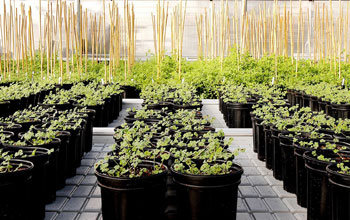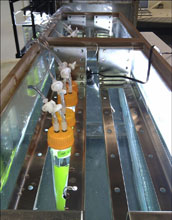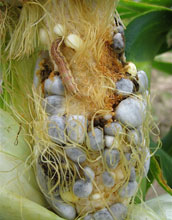All Images
News Release 11-239
The U.S. National Science Foundation and Japan Science and Technology Agency Issue New Joint Awards to Reduce Pesticide Pollution and Promote Biofuel
The carbon footprint of humans will be reduced by four awards for plant and microbial research issued under a new joint U.S./Japanese program
This material is available primarily for archival purposes. Telephone numbers or other contact information may be out of date; please see current contact information at media contacts.

A plant called Medicago truncatula grows in the Samuel Roberts Noble Foundation greenhouse in Ardmore, Oklahoma. The Sumner/Saito team will identify and characterize important metabolites related to biomass and oil production in plants.
Credit: Broderick Stearns, Noble Foundation
Download the high-resolution JPG version of the image. (475 KB)
Use your mouse to right-click (Mac users may need to Ctrl-click) the link above and choose the option that will save the file or target to your computer.

Cultures of algae are grown in reactors in the VanderGheynst Laboratory at the University of California at Davis. Variations in the amount of carbon dioxide consumed by growing algae under different environmental conditions are measured. Such research will contribute to the Fiehn/Arita research group's efforts to improve the ability of photosynthetic algae to produce biofuel.
Credit: Professor Fiehn, UC Davis, Gert Wohlgemuth, UC Davis, Kirsten Skogerhson, Monsanto
Download the high-resolution JPG version of the image. (136 KB)
Use your mouse to right-click (Mac users may need to Ctrl-click) the link above and choose the option that will save the file or target to your computer.

A type of photosynthetic bacteria that will be studied as part of the Liao/Fukusaki project, which will be devoted to increasing butanol production.
Credit: Hidevaldo Machado, University of California, Los Angeles
Download the high-resolution JPG version of the image. (234 KB)
Use your mouse to right-click (Mac users may need to Ctrl-click) the link above and choose the option that will save the file or target to your computer.

The damage done to an ear of corn infected by a fungus and corn earworm larvae. Notice how the combined pressure of pests and disease-causing microbial organisms can significantly reduce crop yield. The Jander/Okumoto team will use metabolomics techniques to identify natural chemicals used by plants to fight diseases.
Credit: Eric Schmeiz, USDA-ARS, CMAVE Chemistry Research Unit
Download the high-resolution JPG version of the image. (216 KB)
Use your mouse to right-click (Mac users may need to Ctrl-click) the link above and choose the option that will save the file or target to your computer.


